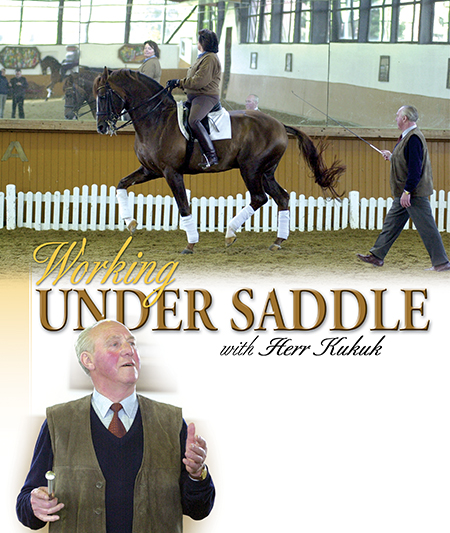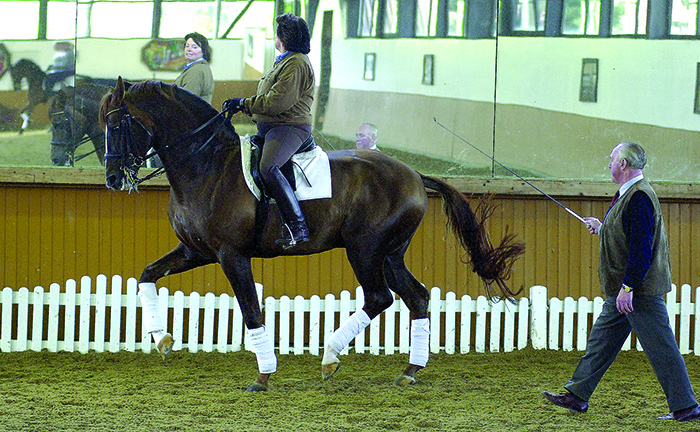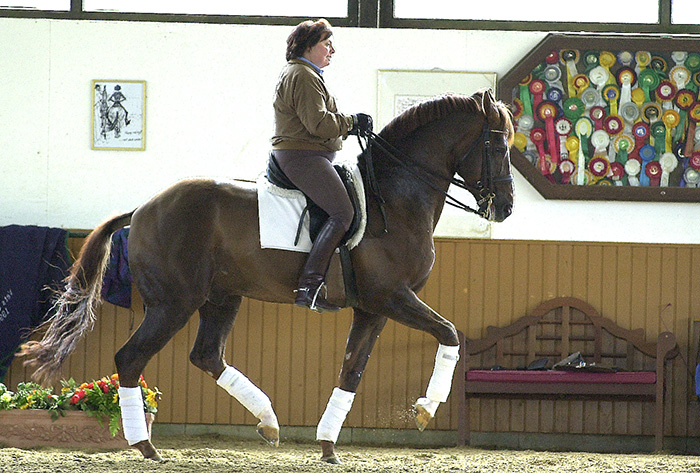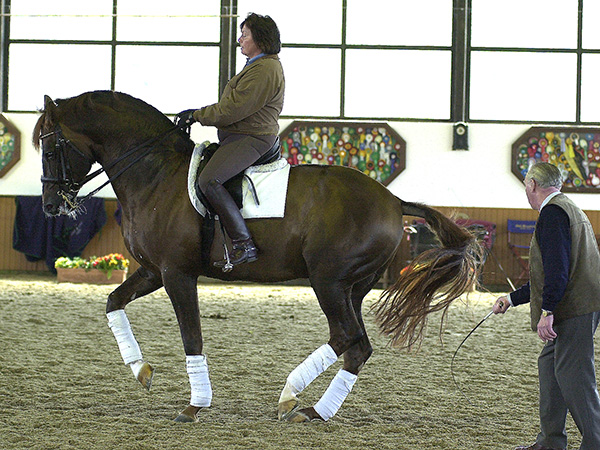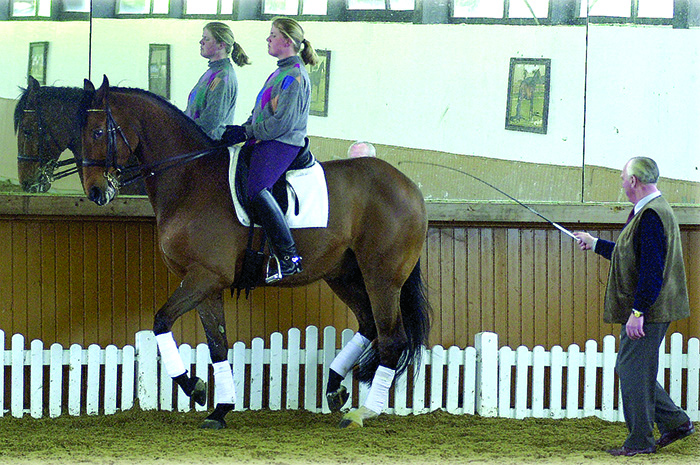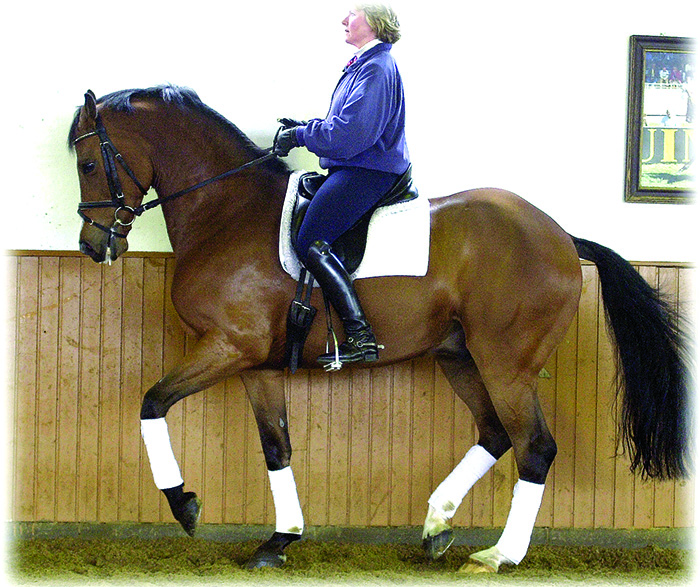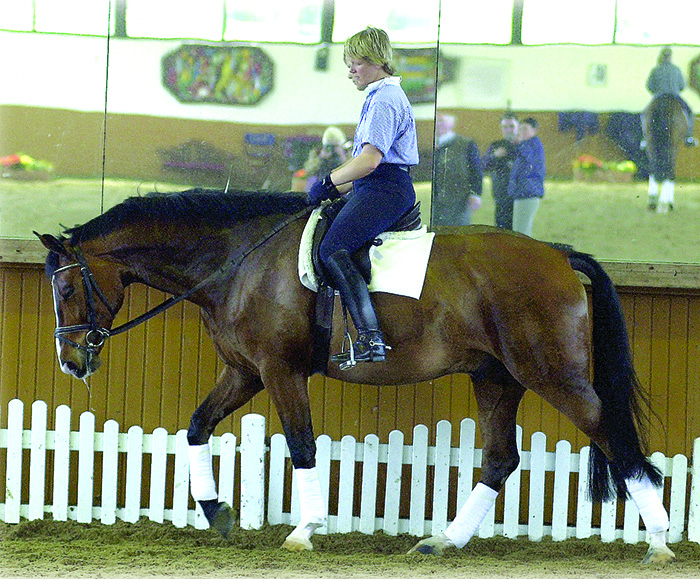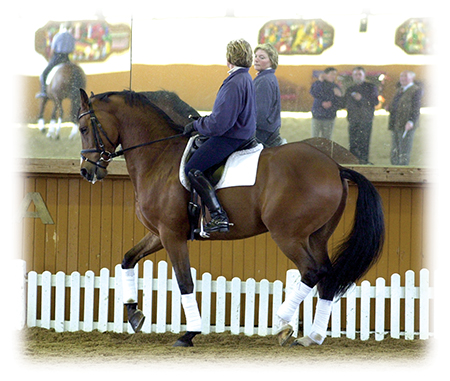“Dressage is all about working with the horse to help him carry himself better and to take up more weight in his hocks.”
The late Franz Kukuk was educated first in the German system, and then at the famed Spanish Riding School in Vienna. Franz Kukuk was legendary for his in hand work, and after his retirement as Trainer from the Westfalen State Stud, he worked with the young horses at the PSI dressage barn until his death. This interview took place at the Kasselmann stables in 2002.
The first horse we saw Herr Kukuk work with is a really impressive individual. The first of the Welt Hit brothers, Welt Hit 0, working with the rider who believed in him even when the Oldenburg licensing commission had rejected him, Bianca Kasselmann.
It is exciting electrifying work, with the liver chestnut alternating between huge extended trot, and fantastic passage. Mr Kukuk explains the theory behind the exercise:
“It is through the transitions from the extended trot to the collected trot, you get the horse into the real suppleness so it can react to the rider. Only through a good extension can you have a good collected trot or a piaffe. Only then can the horse really let go, if you pull him to the collection then he will never piaffe really on his hocks and going over the back -without the horse being stressed anywhere, or tense anywhere.
When you have a good extension, the rider can take the whole fluency, the beat, the power into the collection, and the horse can keep on moving without being pulled or getting stiff. This way all the movement of the extension goes into the collection. The horse can take the expressiveness of the extended trot into the passage because he is so in front of the rider that he can move into a perfect collection easily.”
“The rider has to keep the horse in front of her so he doesn’t get too short in the neck. The horse is really moving onto the bit, he doesn’t want to hide from it with a short closed up neck. The minute they go down in the neck, they get high in the leverage of the back, and in their hocks, and that is something you don’t want. You want them up so that you can really say they are carrying themselves, otherwise it is just pulling at the horse, and that would hurt. Dressage is all about working with the horse to help him carry himself better and to take up more weight in his hocks. When the rider pulls and the horse gets low in front, he has all his weight on the front legs, and obviously that is not very healthy for the horse.”
Steffi, our translator, has had plenty of experience of working with Mr Kukuk on the ground, explains how the ridden sessions are just an extension of the in-hand work which the horses do earlier in the week:
“The rider sits on the horse while Mr Kukuk is behind them with a whip, this is the next step along from the work in hand, the rider can correct and feel and do those little touches that you can’t do if you are not sitting on the horse. You can feel from the top if he is really piaffing properly or whether he is being heavy in the mouth . . . and Mr Kukuk can help from the ground, making each step go properly – before moving on to the next stage when Mr Kukuk just stops doing anything, and the rider takes over and the horse keeps on piaffing without his help.”
“For the first couple of steps Mr Kukuk helps the horse getting the right beat and the right rhythm then the rider takes over and keeps helping the horse into the right rhythm without Mr Kukuk helping with the whip.”
“Once the rider has taken over Mr Kukuk doesn’t really do anything, he just stays with the horse and sees where the horse could be corrected. Right now you see a very nice piaffe, very collected, very under his centre of gravity and under the rider. He is sitting down, getting really deep with his hocks. Mr Kukuk touches him with the whip on the hocks, or the belly, or at the front.”
“With a young horse like this one, the piaffe advances, because the minute they get wrongly pulled into a backward piaffe they lose everything. Obviously they have to keep moving forward, no matter how little the steps are, the piaffe always has to be in a forward motion. So we keep the horse moving forward, especially while it is learning the very important transition between piaffe and passage.”
“The horse will carry himself, if he is really collected. If you don’t make the horse step forward, he very soon learns to step backwards and then he is ruined – it is very hard to get that out, once the horse learns to go backwards in the piaffe.”
“All movements are forward movements, even the rein back. The piaffe cannot be exactly on the spot, it has to move forward even if you can’t see it because the movement is so small. Only on special occasions, for instance if you are riding a test, that is the only time you really come to the spot. But remember even if it looks like it is on the spot, it always has to go a tiny bit forward, that is why in work, we always do the piaffe forward so we are sure they stay in front of the rider.”
“You cannot go directly from a halt into piaffe, there must always be one or two steps of collected walk, especially with the young horses so they learn that piaffe is in a forward motion. Insa has really done a lovely job on this horse; it takes a lot of time, especially with a horse like this that appears to be very light in his neck.”
“Especially at the top part of his neck it is so important that the rider always works on his nose being a little bit in front of the vertical so that you don’t get him too tight.”
“It is important that you don’t do too much in the beginning. Just say ‘okay, that was good’ and then stop. Halt, relax again, try not to overdo it, especially with a horse that offers so much. Leave it so the horses have fun doing it, and the piaffe does not become forced.”
“You have to move from piaffe to passage in a transition that looks like it is not happening. That’s another reason why it is so important to keep the forward movement in the piaffe, even if the horse has to make a step or two of collected trot before going into passage, that is better than the horse getting stuck, and not able to get out of piaffe. The horse has worked very well on the left, but it is important to also take him on the right rein because the change of rein is a big difference for the horses. We start on the left rein at first because 99% of horses are easier to the left but then it is very important for them to become comfortable on the right rein as well.”
Mr Kukuk is pleased: “It is very important that after all this very collected work, they go easily into an extended walk. They have so much trust that they calm down immediately and go to a long rein, and a long extended walk, and they relax. It is no good if you end up with them so hyped up that you can’t do anything with them afterwards. See a totally calm and relaxed walk … see how they stretch out. They are totally supple and trusting and happy after all that work.”
“In the piaffe it is so important to get the magical triangle from the hip joint, to the stifle, to the hock. That is so important in the piaffe, that they really sit back on the hock and they don’t try to move their hock backwards and out and do the piaffe on their front legs. They should have a carrying back, strong and using their hocks, only then can they get into a proper passage, when they have the strength. If the horse is on its front in the piaffe, they will just run into passage, or do the piaffe/passage, not really passage but piaffe moving forward. What is so important is the suppleness that it is really from the back to the front to the hands. The hand must not stop the horse from carrying itself, the horse must trust the hand enough to step into it.”
“Everything should be like a dance. It stays in the rhythm.”
And how does the horse know to move from piaffe to passage?
“From the rider’s back. Collection is about the rider’s back, the horse has to really listen to the rider’s back – and it is very important that the horse always steps under, and uses his hocks to his centre of gravity. If the horse is ridden properly and he takes the back aid, then the rein always bounces, the rider never stops the horse with the rein. The perfect transition is only out of the rider’s back. You can’t kick the horse or you will interfere with the beat. It’s not a hand thing, the rider doesn’t kick like mad, he just sits differently, heavier, until they go forward a bit.”
“It is so important that the horse stays in his own rhythm because then the rider can – without any effort – take the horse back and collect him, or move him forward more. In this collected work, keeping the rhythm is the most important thing. The minute they lose rhythm, they lose expression, they lose everything.”
“If you do the work in hand properly, and give the horse the trust and strength to sit on his hocks, and step over his back, and to keep the diagonal steps, and still stay soft and supple, only then can the rider aid the horse out of the piaffe into the passage with an effortless transition, and back to piaffe.”
“Only horses that trust, and horses that bounce, that are very supple and loose in their neck can do this work – if you don’t have that it will just become a fight. If you try to force the horse with the rein in front then you break the whole movement over the back into the hand. Only when you have that bounce and freedom, can you start a proper piaffe/passage program and it won’t turn into a really tense, forced fight.
This article was first published in December 2001.

